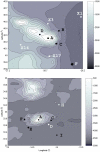Is there a seamount effect on microbial community structure and biomass? The case study of Seine and Sedlo seamounts (northeast Atlantic)
- PMID: 22279538
- PMCID: PMC3261146
- DOI: 10.1371/journal.pone.0029526
Is there a seamount effect on microbial community structure and biomass? The case study of Seine and Sedlo seamounts (northeast Atlantic)
Abstract
Seamounts are considered to be "hotspots" of marine life but, their role in oceans primary productivity is still under discussion. We have studied the microbial community structure and biomass of the epipelagic zone (0-150 m) at two northeast Atlantic seamounts (Seine and Sedlo) and compared those with the surrounding ocean. Results from two cruises to Sedlo and three to Seine are presented. Main results show large temporal and spatial microbial community variability on both seamounts. Both Seine and Sedlo heterotrophic community (abundance and biomass) dominate during winter and summer months, representing 75% (Sedlo, July) to 86% (Seine, November) of the total plankton biomass. In Seine, during springtime the contribution to total plankton biomass is similar (47% autotrophic and 53% heterotrophic). Both seamounts present an autotrophic community structure dominated by small cells (nano and picophytoplankton). It is also during spring that a relatively important contribution (26%) of large cells to total autotrophic biomass is found. In some cases, a "seamount effect" is observed on Seine and Sedlo microbial community structure and biomass. In Seine this is only observed during spring through enhancement of large autotrophic cells at the summit and seamount stations. In Sedlo, and despite the observed low biomasses, some clear peaks of picoplankton at the summit or at stations within the seamount area are also observed during summer. Our results suggest that the dominance of heterotrophs is presumably related to the trapping effect of organic matter by seamounts. Nevertheless, the complex circulation around both seamounts with the presence of different sources of mesoscale variability (e.g. presence of meddies, intrusion of African upwelling water) may have contributed to the different patterns of distribution, abundances and also changes observed in the microbial community.
Conflict of interest statement
Figures







Similar articles
-
Decrease in the autotrophic-to-heterotrophic biomass ratio of picoplankton in oligotrophic marine waters due to bottle enclosure.Appl Environ Microbiol. 2011 Aug 15;77(16):5739-46. doi: 10.1128/AEM.00066-11. Epub 2011 Jul 8. Appl Environ Microbiol. 2011. PMID: 21742930 Free PMC article.
-
Latitudinal distribution of prokaryotic picoplankton populations in the Atlantic Ocean.Environ Microbiol. 2009 Aug;11(8):2078-93. doi: 10.1111/j.1462-2920.2009.01929.x. Epub 2009 Apr 30. Environ Microbiol. 2009. PMID: 19453607
-
Biogeographic patterns and community assembly mechanisms of bacterial community in the upper seawater of seamounts and non-seamounts in the Eastern Indian Ocean.Appl Environ Microbiol. 2024 Sep 18;90(9):e0142424. doi: 10.1128/aem.01424-24. Epub 2024 Aug 16. Appl Environ Microbiol. 2024. PMID: 39150264 Free PMC article.
-
The Biology of Seamounts: 25 Years on.Adv Mar Biol. 2018;79:137-224. doi: 10.1016/bs.amb.2018.06.001. Epub 2018 Jul 6. Adv Mar Biol. 2018. PMID: 30012275 Review.
-
Fate of heterotrophic microbes in pelagic habitats: focus on populations.Microbiol Mol Biol Rev. 2005 Sep;69(3):440-61. doi: 10.1128/MMBR.69.3.440-461.2005. Microbiol Mol Biol Rev. 2005. PMID: 16148306 Free PMC article. Review.
Cited by
-
Virioplankton distribution in the tropical western Pacific Ocean in the vicinity of a seamount.Microbiologyopen. 2020 Jun;9(6):1207-1224. doi: 10.1002/mbo3.1031. Epub 2020 Mar 16. Microbiologyopen. 2020. PMID: 32180355 Free PMC article.
-
Distribution Patterns of Microbial Community Structure Along a 7000-Mile Latitudinal Transect from the Mediterranean Sea Across the Atlantic Ocean to the Brazilian Coastal Sea.Microb Ecol. 2018 Oct;76(3):592-609. doi: 10.1007/s00248-018-1150-z. Epub 2018 Feb 14. Microb Ecol. 2018. PMID: 29442157
-
Ubiquitous, B12-dependent virioplankton utilizing ribonucleotide-triphosphate reductase demonstrate interseasonal dynamics and associate with a diverse range of bacterial hosts in the pelagic ocean.ISME Commun. 2023 Oct 3;3(1):108. doi: 10.1038/s43705-023-00306-9. ISME Commun. 2023. PMID: 37789093 Free PMC article.
-
Baseline Assessment of Mesophotic Reefs of the Vitória-Trindade Seamount Chain Based on Water Quality, Microbial Diversity, Benthic Cover and Fish Biomass Data.PLoS One. 2015 Jun 19;10(6):e0130084. doi: 10.1371/journal.pone.0130084. eCollection 2015. PLoS One. 2015. PMID: 26090804 Free PMC article.
-
Bacterioplankton reveal years-long retention of Atlantic deep-ocean water by the Tropic Seamount.Sci Rep. 2020 Mar 13;10(1):4715. doi: 10.1038/s41598-020-61417-0. Sci Rep. 2020. PMID: 32170218 Free PMC article.
References
-
- Wessel P. Seamount characteristics. In: Pitcher TJ, et al., editors. Seamounts: Ecology, Conservation and Management. Fish and Aquatic Resources Series 12. Oxford: Blackwell Publishing; 2007. pp. 3–25.
-
- Wessel P, Sandwell DT, Kim SS. The global seamounts census. Oceanography. 2010;23:24–33.
-
- White M, Bashmachnikov I, Arístegui J, Martins A. Physical processes and seamount productivity. In: Pitcher TJ, et al., editors. Seamounts: Ecology, Conservation and Management. Fish and Aquatic Resources Series 12. Oxford: Blackwell Publishing; 2007. pp. 65–84.
-
- Bashmachnikov I, Mohn C, Pelegri JL, Martins A, Jose F, et al. Interaction of Mediterranean water eddies with Sedlo and Seine seamounts, subtropical Northeast Atlantic. Deep-Sea Res Pt II. 2009;56:2593–2605.
-
- Tokarev YN, Bityukov EP, Williams R. Influence of seamounts at the Atlantic Ocean on modification of the bioluminescence and plankton characteristics. Marine Ecological Journal. 2003;2:46–58.
Publication types
MeSH terms
Substances
LinkOut - more resources
Full Text Sources

